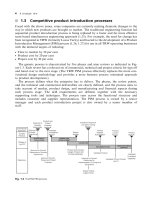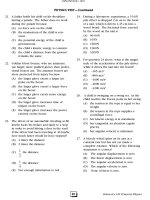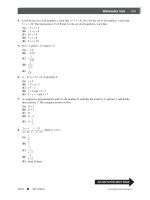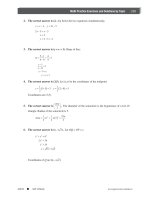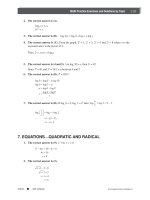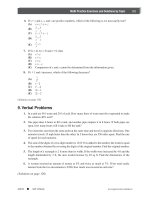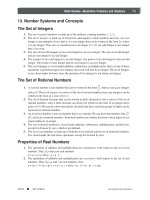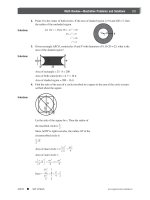SAT II Biology Episode 1 Part 2 ppsx
Bạn đang xem bản rút gọn của tài liệu. Xem và tải ngay bản đầy đủ của tài liệu tại đây (182.71 KB, 20 trang )
20. Which of the following types of learning
behavior is responsible for allowing you to
ignore the constant sensation to your body
caused by the clothes you are wearing?
(A) habituation
(B) association
(C) imprinting
(D) imitation
(E) innovation
Directions: Each of the lettered choices below refers to the statements immediately following it.
Select the lettered choice that best fits each statement. A choice may be used once, more than
once, or not at all.
Questions 21–23 refer to the following pairs
of organisms:
(A) monocot and dicot
(B) algae and fungi
(C) mosses and ferns
(D) ferns and gymnosperms
(E) gymnosperms and angiosperms
21. One produces spores, whereas the other
produces seeds.
22. One is photosynthetic, whereas the other is
saprophylic.
23. One contains xylem and phloem, whereas
the other does not.
Questions 24–26 refer to the following
ter ms:
(A) vascular cambium
(B) ground tissue
(C) apical meristem
(D) phloem
(E) xylem
24. Responsible for movement of water and
dissolved nutrients from the roots upward
in the plant.
25. Responsible for the movement of sugars
made in the leaves downward through the
plant.
26. Responsible for primary growth (growth in
length) of the plant body.
➡
GO ON TO THE NEXT PAGE
DIAGNOSTIC TEST
DIAGNOSTIC TEST—Continued
17
Peterson’s n SAT II
Success: Biology E/M www.petersons.com
Directions: Each of the questions or statements below is accompanied by five choices. For each
question, select the best of the answer choices given.
27. Which of the following represents the
correct order of appearance of different
vertebrate groups in the fossil record?
(A) fish, birds, reptiles, mammals
(B) amphibians, reptiles, fish, mammals
(C) fish, reptiles, amphibians, mammals
(D) fish, amphibians, reptiles, mammals
(E) fish, amphibians, mammals, reptiles
28. Evidence validating the theory of evolution
based on the study of structures that appear
during the development of different
organisms is known as
(A) comparative homology.
(B) comparative endocrinology.
(C) comparative morphology.
(D) comparative anatomy.
(E) comparative embryology.
29. The concept that the gene pool of an
idealized, non-evolving population remains
constant over generations forms the basis of
(A) Mendel’s principle of segregation.
(B) Mendel’s principle of independent
assortment.
(C) Darwin’s theory of natural selection.
(D) Darwin’s theory of survival of the
fittest.
(E) the principle of Hardy-Weinberg
equilibrium.
30. The process by which species from
different evolutionary lineages come to
resemble each other as a result of living in
very similar environments is known as
(A) adaptive radiation.
(B) convergent evolution.
(C) sympatric speciation.
(D) allopatric speciation.
(E) punctuated equilibrium.
STOP
IF YOU ARE TAKING THE BIOLOGY-E TEST, CONTINUE WITH QUESTIONS 31–40.
IF YOU ARE TAKING THE BIOLOGY-M TEST, GO TO QUESTION 41 NOW.
DIAGNOSTIC TEST
DIAGNOSTIC TEST—Continued
18
Peterson’s n SAT II
Success: Biology E/Mwww.petersons.com
BIOLOGY-E TEST
Directions: Each of the questions or statements below is accompanied by five choices. Some
questions refer to a laboratory or experimental situation. For each question, select the best of the
answer choices given.
31. Which of the following statements is
correct?
(A) A species is one type of population.
(B) A species is a local subset of a popula-
tion.
(C) A population is a local subset of a
species.
(D) A population encompasses many
different species.
(E) The terms population and species are
interchangeable.
32. Which of the following best describes a
pattern of idealized population growth that
is restricted by limiting factors?
(A) logistic growth model
(B) carrying capacity model
(C) dispersion model
(D) habitat cap model
(E) exponential growth model
33. Which of the following terms best encom-
passes all of the populations of organisms
living together and potentially interacting in
an area?
(A) carrying capacity
(B) biome
(C) ecosystem
(D) biological community
(E) geographical community
34. The human population, from Stone Age
times to the present, is best represented by
(A) an exponential growth curve.
(B) a logistic growth curve.
(C) a bimodel distribution curve.
(D) a normal distribution curve.
(E) a random growth curve.
35. Which of the following would NOT be
considered a density-dependent factor
affecting population size?
(A) competition
(B) parasitism
(C) predation
(D) tornado
(E) disease epidemic
36. If a population exceeds the carrying
capacity of the ecosystem, the most likely
outcome would be
(A) an increase in resources to meet its
needs.
(B) extinction of the species.
(C) an eventual decline in population size.
(D) a steady increase in population size.
(E) maintenance of the current population
size indefinitely.
➡
GO ON TO THE NEXT PAGE
DIAGNOSTIC TEST
DIAGNOSTIC TEST—Continued
19
Peterson’s n SAT II
Success: Biology E/M www.petersons.com
37. The role of a particular species within an
ecosystem, including all of its interactions
with both biotic and abiotic factors, is
known as the species’
(A) ecological niche.
(B) habitat.
(C) carrying capacity.
(D) dispersion pattern.
(E) density pattern.
38. Mutualistic interactions among species in an
ecosystem would be characterized as
(A) −/−.
(B) −/0.
(C) +/0.
(D) +/+.
(E) +/−.
Questions 39–40 refer to the following
population in Hardy-Weinberg equilibrium:
Approximately 4% of the turtle population in
the local pond shows the recessive phenotype—
long nose (nn).
39. What is the frequency of the dominant
allele (N) in the population?
(A) 0.16
(B) 0.20
(C) 0.40
(D) 0.32
(E) 0.80
40. What is the frequency of heterozygotes in
the population?
(A) 0.08
(B) 0.24
(C) 0.32
(D) 0.48
(E) 0.64
STOP
If you answered the first 40 questions STOP HERE.
If you are taking the Biology-M test CONTINUE HERE.
DIAGNOSTIC TEST
DIAGNOSTIC TEST—Continued
20
Peterson’s n SAT II
Success: Biology E/Mwww.petersons.com
BIOLOGY-M TEST
Directions: Each of the questions or statements below is accompanied by five choices. Some
questions refer to a laboratory or experimental situation. For each question, select the best of the
answer choices given.
41. If a molecule of DNA is composed of
approximately 16.2% adenine (A) and 33.4%
guanine (G), the percentages of thymine (T)
and cytosine (C) must be approximately
(A) 16.3% T and 16.3% C.
(B) 34.1% T and 34.1% C.
(C) 34.1% T and 16.3% C.
(D) 16.3% T and 34.1% C.
(E) 33.4% T and 16.2% C.
42. The primary building blocks of a DNA
molecule are
(A) nitrogenous bases, phosphates, and
ribose sugar.
(B) nitrogenous bases, phosphates, and
deoxyribose sugar.
(C) phosphorous bases, nitrogen, and
ribose sugar.
(D) phosphorous bases, nitrogen, and
deoxyribose sugar.
(E) carbon, nitrogen, oxygen, phosphorous,
and deoxyribose sugar.
43. Which of the following procedures would
NOT be likely to lead to the production of
recombinant DNA?
(A) transformation of bacterial cells with
plasmid DNA from another strain of
bacteria
(B) transformation of bacterial cells with
naked DNA from human cells
(C) transduction of bacteria using phage
particles (bacterial viruses)
(D) projectile bombardment of cells with
DNA-coated particles from a ‘gene gun’
(E) the removal of a single somatic cell
from a carrot and regenerating an entire
plant from the cell through tissue
culture
➡
GO ON TO THE NEXT PAGE
DIAGNOSTIC TEST
DIAGNOSTIC TEST—Continued
21
Peterson’s n SAT II
Success: Biology E/M www.petersons.com
44. Which of the following statements does
NOT contribute to the evidence in support
of evolution?
(A) Sequences of fossils have been found
that show a gradual series of changes in
form among organisms.
(B) Species thought to be related through
evolution from a common ancestor
show many anatomical similarities.
(C) The stages of embryological develop-
ment in animals are quite similar among
highly diverse types of organisms.
(D) Similarities in chromosome structure,
DNA sequence, and amino acid
sequence suggest relationships among
organisms descending through evolu-
tion from a common ancestor.
(E) The most well adapted individuals do
not always produce the most fit
offspring.
45. Which of the following statements suggests
that all organisms descended through
evolution from a common ancestor?
(A) There is much evidence for the
occurrence of convergent evolution.
(B) It is widely accepted that natural
selection leads to evolution.
(C) Despite the diversity of organisms on
Earth, all share the same genetic code.
(D) All populations experience mutation
and natural selection.
(E) Selection acts on individuals, but only
populations evolve.
46. Which of the following pairs represents
homologous structures?
(A) human arm and octopus tentacle
(B) human arm and sea star arm
(C) human arm and bird wing
(D) bird wing and fly wing
(E) fly wing and bat wing
47. The relative fitness of an organism in a
population is best measured by
(A) the number of times it mates during its
lifetime.
(B) the size of the offspring it produces.
(C) the number of offspring it produces
each year.
(D) the number of offspring it produces
during its lifetime.
(E) the number of offspring it produces
during its lifetime that survive and
successfully reproduce.
48. According to the biological species concept,
the main criterion for identifying a species
is
(A) morphological distinctiveness.
(B) behavioral distinctiveness.
(C) physiological distinctiveness.
(D) geographical isolation.
(E) reproductive isolation.
DIAGNOSTIC TEST
DIAGNOSTIC TEST—Continued
22
Peterson’s n SAT II
Success: Biology E/Mwww.petersons.com
49. Which of the following is NOT considered a
potential cause of extinction?
(A) introduction of a new predator
(B) introduction of a new parasite
(C) introduction of a new mutation
(D) interspecific competition for limited
resources
(E) habitat destruction
50. Which of the following statements is NOT a
feature of restriction fragment length
polymorphisms?
(A) They can be used to detect single gene
mutations in human DNA.
(B) They can be used prenatally to analyze
fetal cells for genetic disorders.
(C) They can be used to amplify large
quantities of a single gene through use
of the polymerase chain reaction.
(D) They can be used to detect variation in
DNA sequences among individuals.
(E) They can be separated by electrophore-
sis according to fragment size.
STOP
If you finish before the hour is up, you may review your work on this test only. You may not turn to
any other test in this book.
DIAGNOSTIC TEST
DIAGNOSTIC TEST—Continued
23
Peterson’s n SAT II
Success: Biology E/M www.petersons.com
ANSWERS AND EXPLANATIONS
QUICK-SCORE ANSWERS
1. D
2. B
3. C
4. E
5. B
6. A
7. D
8. E
9. B
10. E
11. D
12. E
13. C
14. B
15. A
16. C
17. C
18. E
19. D
20. A
21. D
22. B
23. C
24. E
25. D
26. C
27. D
28. E
29. E
30. B
31. C
32. A
33. D
34. A
35. D
36. C
37. A
38. D
39. E
40. C
41. D
42. B
43. E
44. E
45. C
46. C
47. E
48. E
49. C
50. C
1. The correct answer is (D). Mitochondria are cellular organelles
bound by double membranes. They are the sites where respira-
tion occurs, resulting in the production of ATP. Therefore, they
are the main sites of energy production for the cell. Both plant
and animal cells contain mitochondria, as do most eukaryotic
cells. Prokaryotic cells lack membrane-bound organelles and an
organized nucleus.
2. The correct answer is (B). Ribosomes serve as sites for protein
synthesis in the cell. Mitochondria are the main sites of cellular
energy production.
3. The correct answer is (C). The solute concentration inside a
human red blood cell is greater than that of distilled water. If
such a cell was placed in distilled water, the water concentration
outside the cell would be greater than the water concentration
inside the cell, and the cell would take up water by osmosis.
Animal cells do not have cell walls to prevent unlimited expan-
sion, thus the cell would lyse (swell until it burst).
4. The correct answer is (E). Enzymes are one type of protein.
Lipids include fats, waxes, phospholipids, and steroids that are
insoluble in water. Both sugar and starch are carbohydrates.
Simple, single-unit sugars such as glucose are monosaccharides.
Starch is composed of long chains of glucose molecules and,
thus, forms a more complex carbohydrate known as a polysac-
charide.
5. The correct answer is (B). Transcription is the synthesis of
RNA from a DNA template. Translation is the synthesis of a
polypeptide using the genetic information encoded in an mRNA
24
Peterson’s n SAT II
Success: Biology E/Mwww.petersons.com
molecule. It involves the conversion of a nucleotide “language”
to an amino acid “language.”
6. The correct answer is (A). The change of seasons that occurs
throughout the year results from changes in the tilt of the Earth’s
axis toward or away from the sun during its annual orbit.
7. The correct answer is (D). The two fundamental processes
that govern the dynamics of an ecosystem are energy flow and
chemical cycling. Energy flow involves the passage of energy
through the components of an ecosystem. Energy enters an
ecosystem as sunlight and leaves the ecosystem as heat (a
byproduct of the use of various forms of chemical energy by the
organisms present). Energy is not recycled through the system
and must be continually replaced in the form of sunlight. Thus,
energy is said to flow through a system rather than cycle through
it. Chemical cycling involves the circular movement of materials
within an ecosystem. Chemical elements (such as carbon,
nitrogen, and phosphorous) are cycled between abiotic compo-
nents (air, water, soil) and biotic components (plants, animals,
microorganisms) of an ecosystem.
8. The correct answer is (E). Coevolution involves evolutionary
change in which adaptations in one species act as a selective
force on a second species, including adaptations that in turn act
as a selective force on the first species.
9. The correct answer is (B). Bioremediation involves the use of
living organisms to detoxify polluted areas of an ecosystem.
10. The correct answer is (E). The earthworm represents a
decomposer—an organism that obtains energy from organic
wastes and dead organisms. In this example, the earthworm
might feed on decaying organic matter formed by any of the
other organisms in the food chain. The sunflower represents a
producer (an autotrophic organism). The consumption of the
sunflower by the caterpillar makes it a primary consumer
(feeding directly on a producer). The bluejay, feeding on a
primary consumer, represents a secondary consumer while the
tomcat represents a tertiary consumer. The earthworm would not
represent a quaternary consumer because it does not consume
the living tomcat, although it may feed off organic matter from
the decaying carcass of the tomcat once it dies.
11. The correct answer is (D). Events that occur during the
process of meiosis (crossing over, independent assortment) result
in the production of gametes that are genetically variable. The
two separate divisions that occur during meiosis lead to the
formation of four genetically variable gametes, each with half the
number of chromosomes as the original parent cell (haploid
ANSWERS AND EXPLANATIONS
25
Peterson’s n SAT II
Success: Biology E/M www.petersons.com
condition). When two gametes unite at fertilization, the diploid
condition is restored in the resulting zygote.
12. The correct answer is (E). The products of meiosis are four
gametes, each with half the number of chromosomes as the
original parent cell.
13. The correct answer is (C). Questions 13–14 pertain to Mende-
lian inheritance of traits. You are asked to draw conclusions
about the inheritance of two traits from the results of the
breeding experiment presented in the introductory material.
First, you should observe that the only traits occurring in the F
1
generation are brown coat color and long tails, whereas all four
traits show up among the F
2
progeny. This suggests that brown
coat color and long tails are dominant over white coat color and
short tails, respectively. The parents must have been homozygous
for each trait, as only the dominant traits were present among
their offspring. Thus, the parent with a brown coat and short tail
must have been homozygous dominant for coat color and
homozygous recessive for tail length, whereas the parent with a
white coat and long tail must have been homozygous recessive
for coat color and homozygous dominant for tail length.
14. The correct answer is (B). This question tests your knowledge
of inheritance patterns. The ratio produced in the F
2
(9:3:3:1)
could only have occurred if two different genes control the
inheritance of coat color and tail length, and those genes reside
on separate chromosomes (i.e., they are not linked). A simple
Punnet square derived from intermating the F
1
generation would
reveal the 9 genotypes represented by the four phenotypic
classes found among the F
2
progeny.
15. The correct answer is (A). Tissues are composed of many cells
with similar structure and function working cooperatively as a
unit to carry out a specific role. An organ is usually composed of
two or more tissues (e.g., the heart contains muscle tissue,
epithelial tissue, connective tissue, and nervous tissue). An organ
system is composed of several organs that work together to carry
out a particular body function (e.g., the cardiovascular system
includes the heart, which pumps the blood, and the blood
vessels that transport the blood throughout the body).
16. The correct answer is (C). Food is ingested (eaten), then
enzymes in saliva and stomach secretions digest the food
particles (break them down) so they can be absorbed. Non-
digested food particles are eliminated as waste.
17. The correct answer is (C). During gas exchange, animals take
in oxygen and give off carbon dioxide as respiration occurs,
whereas plants take in carbon dioxide and release oxygen to the
DIAGNOSTIC TEST
26
Peterson’s n SAT II
Success: Biology E/Mwww.petersons.com
atmosphere as a byproduct of photosynthesis. Plants also release
a small amount of carbon dioxide through respiration.
18. The correct answer is (E). Homeostasis involves the regulation
of bodily functions.
19. The correct answer is (D). Humans have chemoreceptors in
their noses and mouths.
20. The correct answer is (A). Habituation is a learning behavior in
which the individual learns not to respond to a repeated stimulus
that conveys little or no information. Association, choice (B), is a
learning behavior in which the individual learns that a particular
stimulus or response is linked to a reward or punishment.
Imprinting, choice (C), is a learning behavior that is limited to a
certain period in an organism’s life and is irreversible. Imitation,
choice (D), is a learning behavior in which the individual learns
by observing and mimicking (imitating) others. Innovation,
choice (E), is a learning behavior in which the individual uses
inventive behavior in response to a new situation without trial
and error or imitation.
21. The correct answer is (D). This question asks you to distin-
guish between plants that reproduce by spores (ferns) and those
that reproduce by seeds (gymnosperms) and thus are more
advanced on an evolutionary scale.
22. The correct answer is (B). This question asks you to recognize
the difference between two organisms that were once thought to
be members of the plant kingdom but that are now classified sepa-
rately. The algae (in kingdom Protista) contain chlorophyll and
various accessory pigments and are able to carry out photosynthe-
sis. Fungi are currently classified in their own kingdom (kingdom
Fungi). These organisms lack photosynthetic pigments and are
typically saprobic (absorbing nutrients from nonliving material) or
parasitic (absorbing nutrients from a living host organism).
23. The correct answer is (C). This question asks you to recognize
the difference between plants lacking vascular tissue (xylem and
phloem), which are quite restricted in size (mosses), and those
that contain vascular tissue and which are able to obtain consid-
erable height (ferns).
24. The correct answer is (E). Xylem tissue consists of several cell
types, most of which are nonliving at maturity, and is responsible
for conducting water and dissolved minerals upward from the
roots where they are absorbed.
25. The correct answer is (D). Phloem tissue consists of several
types of food-conducting cells and is responsible for transporting
sugars made in the leaves during photosynthesis, along with
ANSWERS AND EXPLANATIONS
27
Peterson’s n SAT II
Success: Biology E/M www.petersons.com
those stored in other parts of the plant body, to regions of the
plant requiring energy.
26. The correct answer is (C). Apical meristems are regions of
actively dividing tissue in plants that give rise to growth in length.
They are typically found in shoot tips and root tips.
27. The correct answer is (D).
28. The correct answer is (E). Comparative embryology is the
study of structures that appear during the development of
different organisms.
29. The correct answer is (E).
30. The correct answer is (B). Convergent evolution occurs when
species from different evolutionary lineages come to resemble
each other as a result of living in very similar environments.
Adaptive radiation, choice (A), is the emergence of numerous
species from a common ancestor introduced into new and
different environments. Sympatric speciation, choice (C), is the
formation of a new species as a result of genetic change that
produces a reproductive barrier between the changed (mutant)
population and the original population. Allopatric speciation,
choice (D), is the formation of a new species as a result of an
ancestral population’s becoming isolated by a geographical
barrier. Punctuated equilibrium, choice (E), is the concept that
species formation occurs in spurts followed by long periods of
little or no speciation.
BIOLOGY-E TEST
31. The correct answer is (C). A population is a group of interact-
ing individuals belonging to the same species and living in the
same geographic area.
32. The correct answer is (A). A logistic growth model depicts the
pattern of idealized population growth that is restricted by
limiting factors. The other common growth model listed, an
exponential growth model, choice (E), depicts the pattern of
idealized population growth that is unregulated.
33. The correct answer is (D).
34. The correct answer is (A). Human population growth is
occurring at a continuously accelerating rate that is characteristic
of an exponential growth curve. This exponential growth rate
has been possible because humans have overcome much
environmental resistance and have increased the carrying
capacity of the Earth.
DIAGNOSTIC TEST
28
Peterson’s n SAT II
Success: Biology E/Mwww.petersons.com
35. The correct answer is (D). Density-dependent factors have an
increased effect on population size as the density of the popula-
tion increases (e.g., predation, parasitism, disease, and competi-
tion). The affect of weather phenomena and natural disasters
(e.g., tornadoes) are independent of population density and, thus,
are referred to as density-independent factors.
36. The correct answer is (C). The carrying capacity of an ecosys-
tem is the maximum population size it can support indefinitely;
it is usually based on the availability of resources. If a population
exceeds the carrying capacity of the ecosystem, it will eventually
decline in size until it returns to a size that can be sustained
indefinitely (carrying capacity).
37. The correct answer is (A).
38. The correct answer is (D). In mutualistic interactions among
species, both species gain some benefit from the interaction
(e.g., the mutualistic interaction between termites and the
particular strains of bacteria that live in their gut; the bacteria
find food and shelter while helping the termite breakdown the
wood material it ingests).
39. The correct answer is (E). By definition, p is used to reflect
the frequency of the dominant allele for a given gene in a
population, whereas q is used to reflect the frequency of the
corresponding recessive allele. p
2
reflects the union of two
gametes, each carrying the dominant allele, and, thus, reflects the
frequency of the homozygous dominant genotype in the popula-
tion. q
2
reflects the union of two gametes, each carrying the
recessive allele and, thus, reflects the frequency of the homozy-
gous recessive genotype in the population. If we know that 4
percent of the population has the recessive genotype, then the
frequency of the recessive allele must be the square root of 0.04
= 0.20. Since p + q = 1, then p =1−q = 0.80. If the trait in
question is governed by co-dominance or incomplete dominance,
such that heterozygotes can be distinguished phenotypically from
homozygous dominant individuals, then, by default, p
2
may also
reflect the frequency of individuals in the population with the
dominant phenotype; however, that is not always the case.
40. The correct answer is (C). A heterozygous individual may
result from the union of a dominant allele from the maternal
parent and a recessive allele from the paternal parent, or it may
result from the union of a recessive allele from the maternal
parent and a dominant allele from the paternal parent. Both
possibilities must be considered when determining the frequency
with which a heterozygous individual could be produced in a
ANSWERS AND EXPLANATIONS
29
Peterson’s n SAT II
Success: Biology E/M www.petersons.com
given population. Thus, the frequency of heterozygotes in this
population would be equal to 2pq = 2(0.80)(0.20) = 0.32.
BIOLOGY-M TEST
41. The correct answer is (D). In the DNA molecule, base pairing
occurs between adenine and thymine, which are held together
by two hydrogen bonds, and base pairing occurs between
guanine and cytosine, which are held together by three hydrogen
bonds. Therefore, the percentages of adenine and thymine would
be similar, as would the percentages of guanine and cytosine.
42. The correct answer is (B). The DNA molecule is composed of
double strands of a sugar-phosphate backbone (with deoxyribose
sugar molecules alternating with phosphate groups) held
together by hydrogen bonds between nitrogenous bases (specifi-
cally, two hydrogen bonds between adenine and thymine; and
three hydrogen bonds between guanine and cytosine).
43. The correct answer is (E). Removing a single cell from an organ-
ism and using it to regenerate an entire new individual through
tissue culture would produce a clone of the original organism. No
genetic recombination would take place. The other procedures
listed can each be used in the production of recombinant DNA.
44. The correct answer is (E). Natural selection is a primary
driving force in evolution. The concept of natural selection is
based on the inheritance of traits over generations that confer
adaptation to the environment. Those individuals that are best
adapted to their environment are more likely to produce off-
spring showing the adaptation and will subsequently survive to
successfully reproduce. All of the other choices are areas of study
that have provided (and continue to provide) significant evidence
in support of evolution.
45. The correct answer is (C). The fact that all organisms share a
universal genetic code suggests the code evolved once early in
evolutionary history.
46. The correct answer is (C). The human arm and the wing of a
bird are homologous structures—structures that differ in function
but have similar anatomy, presumably because the organisms that
possess them have a common ancestor.
47. The correct answer is (E). Fitness is the degree to which an
organism is adapted to survive and perpetuate its genes in a
given environment.
48. The correct answer is (E). According to the biological species
concept, a species is a population or group of populations whose
DIAGNOSTIC TEST
30
Peterson’s n SAT II
Success: Biology E/Mwww.petersons.com
members have the potential in nature to interbreed and produce
fertile offspring. Thus, reproductive isolation between groups
would not fit the biological species concept.
49. The correct answer is (C). The introduction of a mutation into a
population allows for genetic variation within the population and
the potential for particular genotypes to be selected for or against.
As such, mutation is an important contributor to evolution. Intro-
duction of a parasite or predator into a population that did not
exist there previously could wipe out an entire population or spe-
cies. Interspecific competition could lead to the displacement or
extinction of the less competitive species. Habitat destruction is a
significant contributor to extinction of species.
50. The correct answer is (C).
ANSWERS AND EXPLANATIONS
31
Peterson’s n SAT II
Success: Biology E/M www.petersons.com
Unit I—Molecules and
Cells
CHEMISTRY—ATOMS AND COMPOUNDS
OVERVIEW
Appreciation for the unity of life on earth must begin with an
understanding of the diversity of the building blocks, beginning at
the atomic level. More than 90 naturally occurring elements combine
in what seems to be an infinite number of ways to produce surpris-
ingly similar classes of chemical compounds, both inorganic and
organic. In addition to composition, these substances bond their
elements together in a variety of ways. Organisms and organic
molecules are complex. Complexity derives from using atoms,
information, and energy. On the SAT II Biology test, the student
should expect a detailed assessment of the properties, structures,
formation, and breakdown of these substances. In addition, the
student is expected to know the role and the effect of energy in the
interactions between elements and compounds, particularly in the
anabolism and catabolism of the chemicals of life. We begin, then, at
the atomic level.
CHEMISTRY
ELEMENTS
Elements are forms of matter that cannot be broken down into any
simpler form by ordinary means. The more than 100 elements on the
periodic chart are distinctly different from one another in discreet
ways.
35
Peterson’s n SAT II
Success: Biology E/M www.petersons.com
Atoms
An atom is the smallest part of an element that is still that element
and is composed of more than 40 subatomic particles. The three
main subatomic particles are the proton, neutron, and electron.
A. Nucleus
Dense center of the atom where most of the mass is concentrated.
1. Proton—Positive particle in the nucleus of an atom; its mass is
arbitrarily set as 1 for the purpose of calculating the mass of an
atom.
2. Neutron—Neutral particle in the nucleus of the atom, generally
agreed to be a proton and an electron combined. Its mass
number is also considered to be equal to 1 for the purpose of
calculating the mass of an atom, since the electron is 1/1837 the
mass of a proton and is, therefore, not significant in mass
calculations.
B. Orbital(s)
1. Electron—Negative particle that remains some distance from the
nucleus while still being a part of the atom.
2. Atomic Models
• Planetary—Abandoned theory that had electrons orbiting
the nucleus as the planets in a solar system orbit a central
star. For the purpose of writing structural formulae of
atoms and compounds, we usually use this model.
• Bohr—Indicated that electrons were discreet packets of
energy placed outside the nucleus, depending on their
present quantum or energy state.
• Electron Cloud Model—Current theory that states, as best
we can determine, the location of the electron is a
CHAPTER 1
36
Peterson’s n SAT II
Success: Biology E/Mwww.petersons.com
